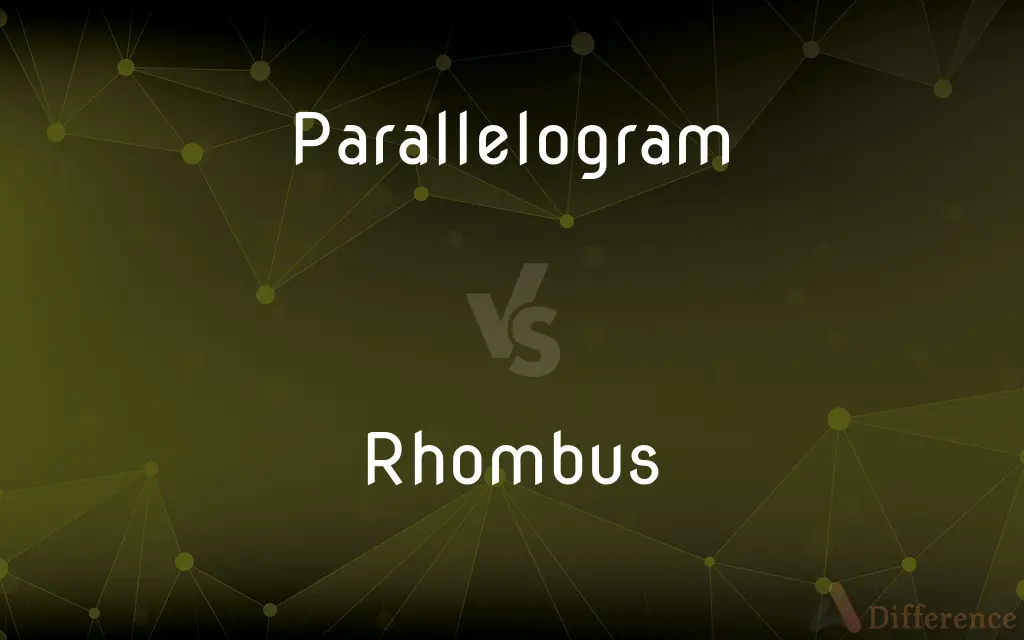Parallelogram vs. Rhombus — What's the Difference?
By Urooj Arif & Maham Liaqat — Updated on April 22, 2024
A parallelogram is a four-sided shape with opposite sides parallel, while a rhombus, a type of parallelogram, has all sides of equal length.

Difference Between Parallelogram and Rhombus
Table of Contents
ADVERTISEMENT
Key Differences
A parallelogram features two pairs of parallel sides. In contrast, a rhombus is defined not just by parallel sides but by having all four sides equal in length.
The angles in a parallelogram vary, and it does not necessarily have equal angles. However, a rhombus has equal opposite angles, which are typically acute and obtuse.
In terms of diagonals, a parallelogram has diagonals that bisect each other but are not necessarily equal. Conversely, the diagonals of a rhombus are perpendicular and bisect each other at right angles, forming equal segments.
Symmetry is another differing factor; parallelograms typically have a center of symmetry. On the other hand, rhombuses possess both line and rotational symmetries due to their equilateral nature.
Regarding area calculation, the area of a parallelogram is the base times the height. While the area of a rhombus can also be calculated this way, it can alternatively be computed using the product of its diagonals divided by two.
ADVERTISEMENT
Comparison Chart
Sides
Opposite sides parallel
All sides equal in length
Angles
Opposite angles equal
Opposite angles equal and rhombus often features acute and obtuse angles
Diagonals
Bisect each other
Bisect each other at right angles
Symmetry
Center of symmetry
Line and rotational symmetries
Area Calculation Formula
Area = base × height
Area = ½ × (diagonal1 × diagonal2)
Compare with Definitions
Parallelogram
A quadrilateral with both pairs of opposite sides parallel.
The area of a parallelogram is calculated as the base times the height.
Rhombus
A common figure in geometry problems.
The problem asked to calculate the area of a rhombus.
Parallelogram
A shape often used in tiling patterns due to its tessellation properties.
The artist used a parallelogram pattern for the mosaic floor.
Rhombus
A parallelogram with all four sides of equal length.
A square is a rhombus with all right angles.
Parallelogram
Can be a rectangle if all angles are right angles.
Every rectangle is a parallelogram with equal angles.
Rhombus
Has applications in various fields such as physics and engineering.
Rhombus patterns are essential in certain structural designs.
Parallelogram
May appear as a slanted rectangle.
When you tilt a rectangle, it becomes a parallelogram.
Rhombus
Its diagonals bisect the interior angles.
In a rhombus, each diagonal cuts the angle in half.
Parallelogram
Used in physics to discuss vector addition.
Vectors can be added using the parallelogram rule.
Rhombus
Known for its diamond shape in common usage.
The sign showed a rhombus to indicate caution.
Parallelogram
In Euclidean geometry, a parallelogram is a simple (non-self-intersecting) quadrilateral with two pairs of parallel sides. The opposite or facing sides of a parallelogram are of equal length and the opposite angles of a parallelogram are of equal measure.
Rhombus
In plane Euclidean geometry, a rhombus (plural rhombi or rhombuses) is a quadrilateral whose four sides all have the same length. Another name is equilateral quadrilateral, since equilateral means that all of its sides are equal in length.
Parallelogram
A four-sided plane figure with opposite sides parallel.
Rhombus
A quadrilateral all of whose sides have the same length.
Parallelogram
(geometry) A convex quadrilateral in which each pair of opposite edges are parallel and of equal length.
Rhombus
An equilateral parallelogram, especially one having oblique angles. Also called rhomb.
Parallelogram
Either of two rectangular areas (respectively the large parallelogram and the small parallelogram) abutting the goal line in front of the goal. (Since 1986 officially named the large rectangle and small rectangle, though the older names are still occasionally used.)
Rhombus
(geometry) A parallelogram having all sides of equal length.
Parallelogram
A right-lined quadrilateral figure, whose opposite sides are parallel, and consequently equal; - sometimes restricted in popular usage to a rectangle, or quadrilateral figure which is longer than it is broad, and with right angles.
Rhombus
The rhombus diamond, as one of the suits seen in a deck of playing cards (♦ or ♦).
Parallelogram
A quadrilateral whose opposite sides are both parallel and equal in length
Rhombus
In early Greek religion, an instrument whirled on the end of a string similar to a bullroarer.
Rhombus
Any of several flatfishes, including the brill and turbot, once considered part of the genus Rhombus, now in Scophthalmus.
Rhombus
Snails, now in genus Conus or family Conidae.
Rhombus
Same as Rhomb, 1.
Rhombus
A parallelogram with four equal sides; an oblique-angled equilateral parallelogram
Common Curiosities
Can a rhombus be a square?
Yes, if all angles are right angles, a rhombus can also be a square.
Is every rhombus a parallelogram?
Yes, every rhombus is a parallelogram since it has parallel opposite sides.
What defines a rhombus?
A rhombus is a parallelogram with all sides of equal length.
Can a parallelogram tessellate a plane?
Yes, parallelograms can tessellate a plane without any gaps or overlaps.
How do the diagonals of a parallelogram and a rhombus differ?
In a parallelogram, diagonals bisect each other, while in a rhombus, they bisect each other at right angles and are equal in length.
What is a parallelogram?
A four-sided figure with opposite sides that are parallel.
What types of symmetry does a parallelogram exhibit?
Parallelograms typically exhibit a center of symmetry.
How do you prove a quadrilateral is a parallelogram?
If a quadrilateral has both pairs of opposite sides parallel, it’s a parallelogram.
How is the area of a parallelogram calculated compared to a rhombus?
The area of a parallelogram is calculated as base times height, while the area of a rhombus can also be calculated as half the product of its diagonals.
What are the properties of a parallelogram's angles?
Opposite angles are equal, but they need not be right angles unless it’s a rectangle.
What symmetry does a rhombus have?
A rhombus has both line and rotational symmetries.
What is the significance of a rhombus' equal sides in geometry?
The equal sides of a rhombus ensure that it has unique geometric properties, such as its symmetries and equal opposite angles.
Why might a rhombus be preferred over a parallelogram in certain designs?
Due to its symmetrical properties and aesthetic appeal, a rhombus might be chosen for decorative elements in design and architecture.
How can the properties of a rhombus be applied in real-world scenarios?
In design and construction, the properties of a rhombus are used to enhance structural integrity and aesthetic appeal.
What common objects are shaped like a parallelogram?
Many modern buildings and art designs incorporate parallelogram shapes for visual interest and structural purposes.
Share Your Discovery

Previous Comparison
Skiing vs. Snowboarding
Next Comparison
Transportation vs. TranslocationAuthor Spotlight
Written by
Urooj ArifUrooj is a skilled content writer at Ask Difference, known for her exceptional ability to simplify complex topics into engaging and informative content. With a passion for research and a flair for clear, concise writing, she consistently delivers articles that resonate with our diverse audience.
Co-written by
Maham Liaqat















































